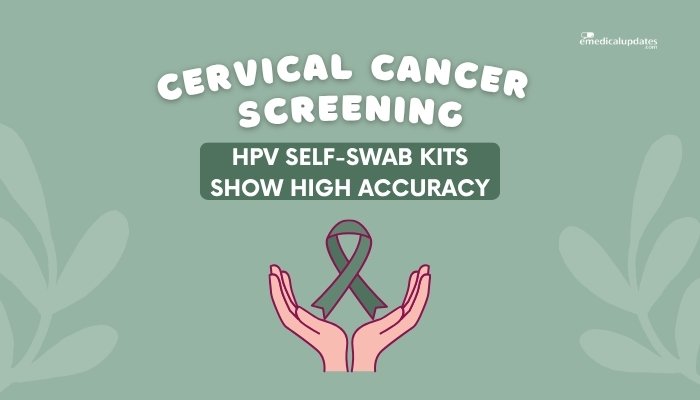Introduction
Cervical cancer ranks among the most preventable cancers, yet thousands of cases still appear each year—many due to lapsed or missed screenings. Traditionally, Pap smears or co-testing (Pap + HPV test) in clinical settings have formed the backbone of cervical cancer screening.
But rising interest surrounds HPV self-swab kits, which allow women to collect their own samples at home. Recent studies reveal that these self-collected samples are highly accurate, potentially boosting screening rates for those who avoid or find clinic-based tests inconvenient.
In this article, we explore how HPV self-swabbing works, what current data says about its accuracy, and the promise it holds for cervical cancer prevention.
Why a Home HPV Test?
Traditional Screening Gaps
Despite evidence that Pap and HPV tests reduce cervical cancer incidence by detecting precancerous lesions, some women do not attend regular screenings because of:
- Embarrassment or Discomfort: Pelvic exams can be awkward or painful.
- Logistical Barriers: Limited access to clinics, scheduling conflicts, or lack of insurance coverage.
- Cultural or Personal Preferences: Privacy concerns or reluctance to undergo invasive procedures.
HPV’s Role
Human Papillomavirus (HPV)—particularly high-risk types like HPV 16 and 18—drives most cervical cancer cases. Detecting the virus early can steer patients toward closer monitoring or prophylactic treatments, well before cancer develops. A self-swab test for HPV might thus expand coverage, reaching women who skip in-clinic exams.
How Self-Swab HPV Kits Work
Sample Collection
Women receive a kit with instructions and a sterile swab or brush:
- Insert the swab into the vagina (not the cervix, so minimal invasiveness).
- Collect a sample of cells and fluids by rotating the swab gently.
- Package and Return the sample in a sealed container to the lab, often via mail.
Lab Analysis
Labs process the specimen for HPV DNA or RNA. If high-risk HPV strains are detected, further evaluation (e.g., a Pap test or colposcopy) may be recommended. If negative, the risk of cervical precancer or cancer is very low.
High Accuracy in Recent Studies
Comparing to Clinician-Collection
Large meta-analyses and observational studies indicate:
- Similar Sensitivity: Self-collected samples for HPV often approach or match the sensitivity (≥90% for high-risk HPV) of clinician-collected samples.
- Comparable Specificity: The rate of false positives remains within an acceptable range, though slightly variable by test brand or technique.
Field Trials
Real-world pilot programs in resource-limited or rural areas, like parts of Latin America or Africa, found that distributing self-test kits increased screening uptake, occasionally doubling or tripling coverage in communities historically lacking routine Pap tests.
Who Benefits Most?
- Women with Limited Access: Those living far from healthcare facilities or with significant scheduling barriers.
- Underserved Populations: Self-swabbing can address cultural or personal obstacles around pelvic exams.
- High-Risk Groups: Women who rarely attend clinic-based screenings but are at higher risk due to lifestyle or immunocompromised status.
Potential Advantages
- Privacy and Convenience: Doing it at home ensures no clinic visit or stirrups, which can ease anxieties.
- Increased Screening Rates: Helps meet guidelines for early detection by removing some main barriers.
- Similar Efficacy: If the test detects HPV accurately, it ensures the same protective effect as standard screening once follow-up is arranged for positive results.
Challenges and Concerns
Follow-Up and Adherence
A test is only beneficial if those testing positive promptly seek further care. Ensuring robust linkage to confirmatory tests—like colposcopy or Pap—remains vital.
Lab Quality and Logistics
Large-scale adoption requires consistent sample quality, lab capacity, stable transport conditions, and standard protocols for analyzing self-collected swabs.
Regulatory and Insurance Coverage
While some high-resource settings have begun integrating self-collection into formal guidelines, many health systems remain uncertain about coverage or official endorsement. More data might be needed to finalize policies.
Future of Self-Swab HPV Testing
Integration into Standard Programs
As acceptance and trust in self-sampling grows, national cervical cancer screening guidelines may incorporate it as an option alongside in-clinic tests. This can drastically expand outreach to unscreened populations.
Technological Upgrades
More sensitive, user-friendly kits or even point-of-care versions (with immediate results) could evolve. Partnerships between device manufacturers and public health agencies may drive cost reductions and refine distribution models.
Toward Elimination of Cervical Cancer
WHO aims to eliminate cervical cancer globally by increasing vaccination, screening, and treatment. Self-sampling for HPV stands to help meet screening targets—especially in settings where formal clinic-based approaches struggle.
Frequently Asked Questions
- Is self-collection as reliable as a Pap smear?
- When used for HPV testing, data suggests high reliability, often comparable to clinician-collected specimens. However, it only screens for HPV, not cell changes.
- Can I replace all recommended Pap tests with this?
- Guidelines differ by region. Some medical authorities see HPV self-testing as an option. Always confirm with local screening recommendations.
- What if I test positive for HPV?
- A follow-up clinical exam or Pap test is essential to assess for cervical cell changes. Early detection helps treat precancerous lesions effectively.
- Is it uncomfortable?
- Most women find it more comfortable than a pelvic exam. Instructions guide minimal insertion. Anxiety is often reduced as it’s self-directed.
- Cost and availability?
- Access and cost vary. Some countries offer pilot programs for free. In others, it might be an out-of-pocket expense unless integrated into national health coverage.
Conclusion
Self-sampling for HPV detection stands out as a pivotal advance in cervical cancer prevention—offering a convenient, private, and accurate method to identify women at risk. By lowering barriers to screening, it has the potential to significantly cut cervical cancer incidence and mortality worldwide, aligning with international goals for elimination. Challenges—like ensuring consistent follow-up for positive tests and refining large-scale logistics—remain, but early results are optimistic. For many, the era of self-collected HPV tests could soon become a mainstream option, helping to transform and broaden cervical cancer screening across diverse populations.
References
-
- Arbyn M, et al. (2018). “Detecting cervical precancer and reaching under-screened women by using HPV testing on self-collected samples.” Int J Cancer.
-
- WHO (2021). “Global strategy to accelerate the elimination of cervical cancer.”
-
- Polman NJ, et al. (2019). “Self-sampling for HPV detection: meta-analysis of accuracy.” BMJ.
-
- Bhatla N, et al. (2020). “Self-sampling for HPV testing: Next steps for women’s health.” Lancet Oncol.







